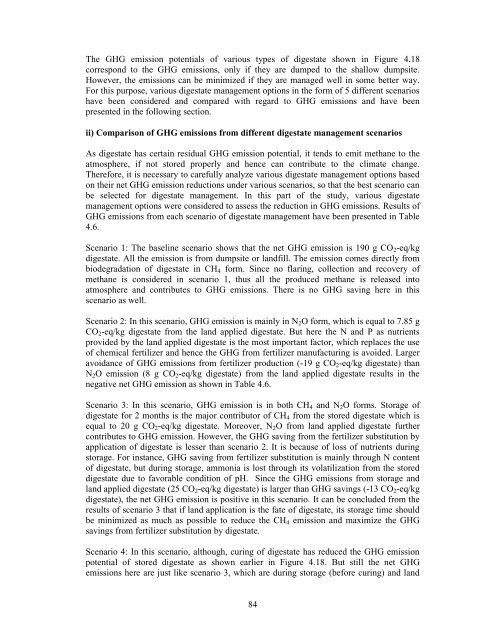dry anaerobic digestion of municipal solid waste and digestate ...
dry anaerobic digestion of municipal solid waste and digestate ...
dry anaerobic digestion of municipal solid waste and digestate ...
Create successful ePaper yourself
Turn your PDF publications into a flip-book with our unique Google optimized e-Paper software.
The GHG emission potentials <strong>of</strong> various types <strong>of</strong> <strong>digestate</strong> shown in Figure 4.18<br />
correspond to the GHG emissions, only if they are dumped to the shallow dumpsite.<br />
However, the emissions can be minimized if they are managed well in some better way.<br />
For this purpose, various <strong>digestate</strong> management options in the form <strong>of</strong> 5 different scenarios<br />
have been considered <strong>and</strong> compared with regard to GHG emissions <strong>and</strong> have been<br />
presented in the following section.<br />
ii) Comparison <strong>of</strong> GHG emissions from different <strong>digestate</strong> management scenarios<br />
As <strong>digestate</strong> has certain residual GHG emission potential, it tends to emit methane to the<br />
atmosphere, if not stored properly <strong>and</strong> hence can contribute to the climate change.<br />
Therefore, it is necessary to carefully analyze various <strong>digestate</strong> management options based<br />
on their net GHG emission reductions under various scenarios, so that the best scenario can<br />
be selected for <strong>digestate</strong> management. In this part <strong>of</strong> the study, various <strong>digestate</strong><br />
management options were considered to assess the reduction in GHG emissions. Results <strong>of</strong><br />
GHG emissions from each scenario <strong>of</strong> <strong>digestate</strong> management have been presented in Table<br />
4.6.<br />
Scenario 1: The baseline scenario shows that the net GHG emission is 190 g CO2-eq/kg<br />
<strong>digestate</strong>. All the emission is from dumpsite or l<strong>and</strong>fill. The emission comes directly from<br />
biodegradation <strong>of</strong> <strong>digestate</strong> in CH4 form. Since no flaring, collection <strong>and</strong> recovery <strong>of</strong><br />
methane is considered in scenario 1, thus all the produced methane is released into<br />
atmosphere <strong>and</strong> contributes to GHG emissions. There is no GHG saving here in this<br />
scenario as well.<br />
Scenario 2: In this scenario, GHG emission is mainly in N2O form, which is equal to 7.85 g<br />
CO2-eq/kg <strong>digestate</strong> from the l<strong>and</strong> applied <strong>digestate</strong>. But here the N <strong>and</strong> P as nutrients<br />
provided by the l<strong>and</strong> applied <strong>digestate</strong> is the most important factor, which replaces the use<br />
<strong>of</strong> chemical fertilizer <strong>and</strong> hence the GHG from fertilizer manufacturing is avoided. Larger<br />
avoidance <strong>of</strong> GHG emissions from fertilizer production ( -19 g CO2-eq/kg <strong>digestate</strong>) than<br />
N2O emission (8 g CO 2-eq/kg <strong>digestate</strong>) from the l<strong>and</strong> applied <strong>digestate</strong> results in the<br />
negative net GHG emission as shown in Table 4.6.<br />
Scenario 3: In this scenario, GHG emission is in both CH4 <strong>and</strong> N2O forms. Storage <strong>of</strong><br />
<strong>digestate</strong> for 2 months is the major contributor <strong>of</strong> CH4 from the stored <strong>digestate</strong> which is<br />
equal to 20 g CO2-eq/kg <strong>digestate</strong>. Moreover, N2O from l<strong>and</strong> applied <strong>digestate</strong> further<br />
contributes to GHG emission. However, the GHG saving from the fertilizer substitution by<br />
application <strong>of</strong> <strong>digestate</strong> is lesser than scenario 2. It is because <strong>of</strong> loss <strong>of</strong> nutrients during<br />
storage. For instance, GHG saving from fertilizer substitution is mainly through N content<br />
<strong>of</strong> <strong>digestate</strong>, but during storage, ammonia is lost through its volatilization from the stored<br />
<strong>digestate</strong> due to favorable condition <strong>of</strong> pH. Since the GHG emissions from storage <strong>and</strong><br />
l<strong>and</strong> applied <strong>digestate</strong> (25 CO2-eq/kg <strong>digestate</strong>) is larger than GHG savings (-13 CO2-eq/kg<br />
<strong>digestate</strong>), the net GHG emission is positive in this scenario. It can be concluded from the<br />
results <strong>of</strong> scenario 3 that if l<strong>and</strong> application is the fate <strong>of</strong> <strong>digestate</strong>, its storage time should<br />
be minimized as much as possible to reduce the CH4 emission <strong>and</strong> maximize the GHG<br />
savings from fertilizer substitution by <strong>digestate</strong>.<br />
Scenario 4: In this scenario, although, curing <strong>of</strong> <strong>digestate</strong> has reduced the GHG emission<br />
potential <strong>of</strong> stored <strong>digestate</strong> as shown earlier in Figure 4.18. But still the net GHG<br />
emissions here are just like scenario 3, which are during storage (before curing) <strong>and</strong> l<strong>and</strong><br />
84

















